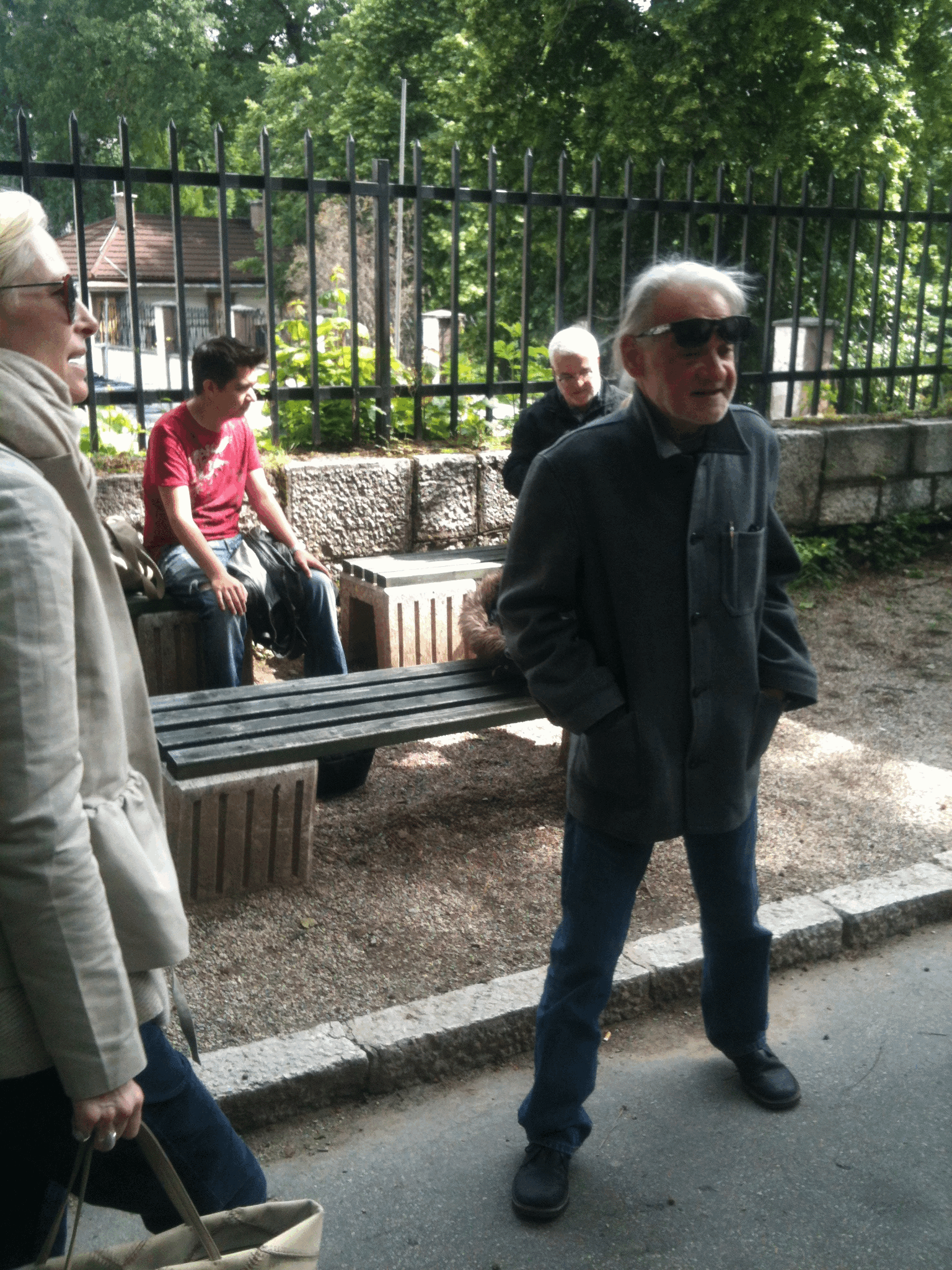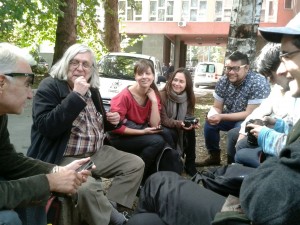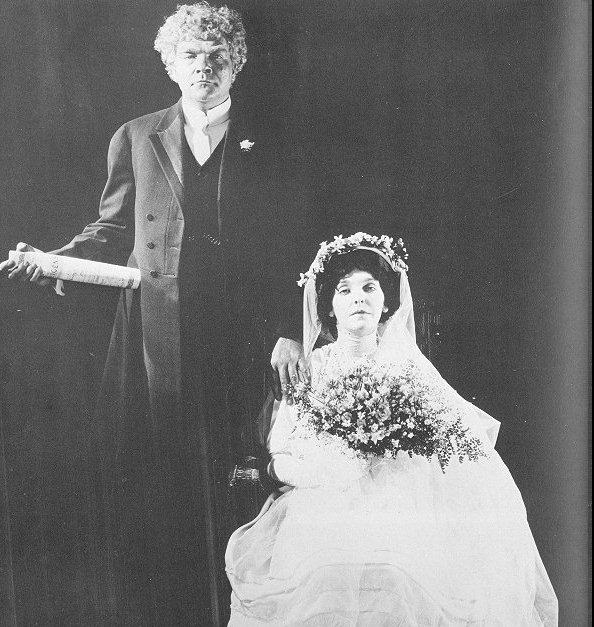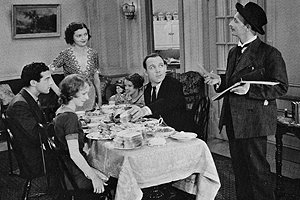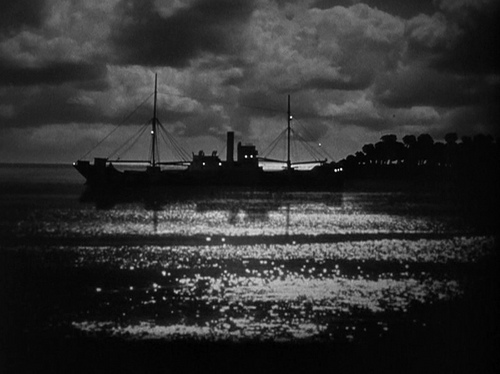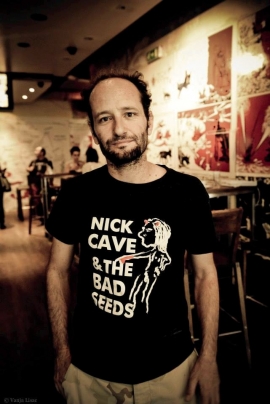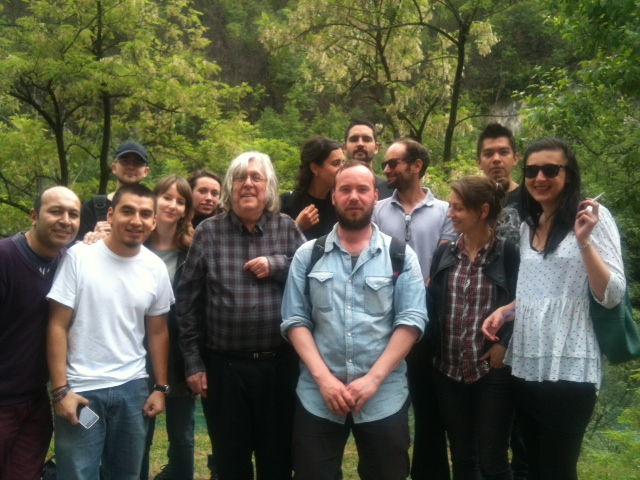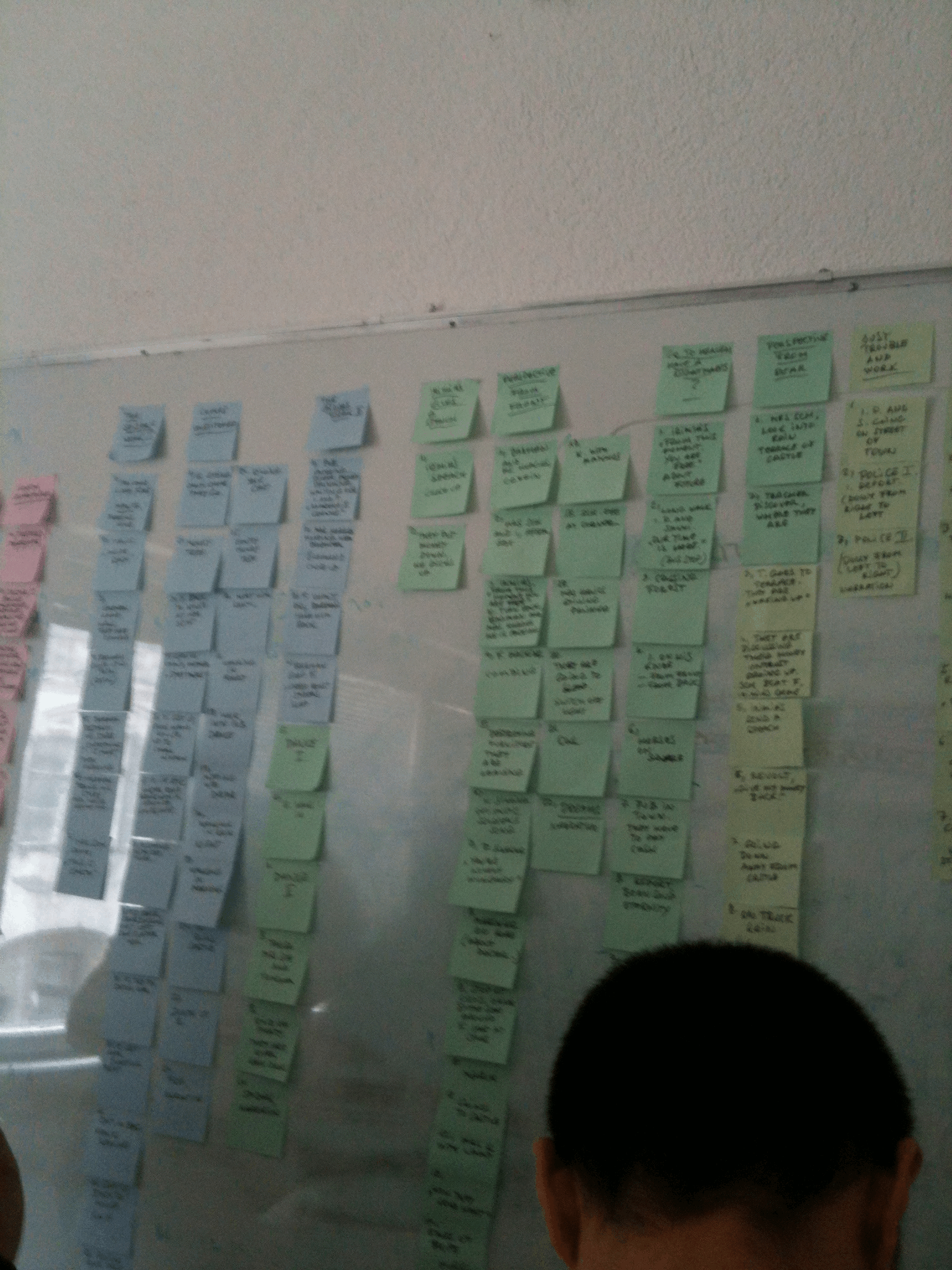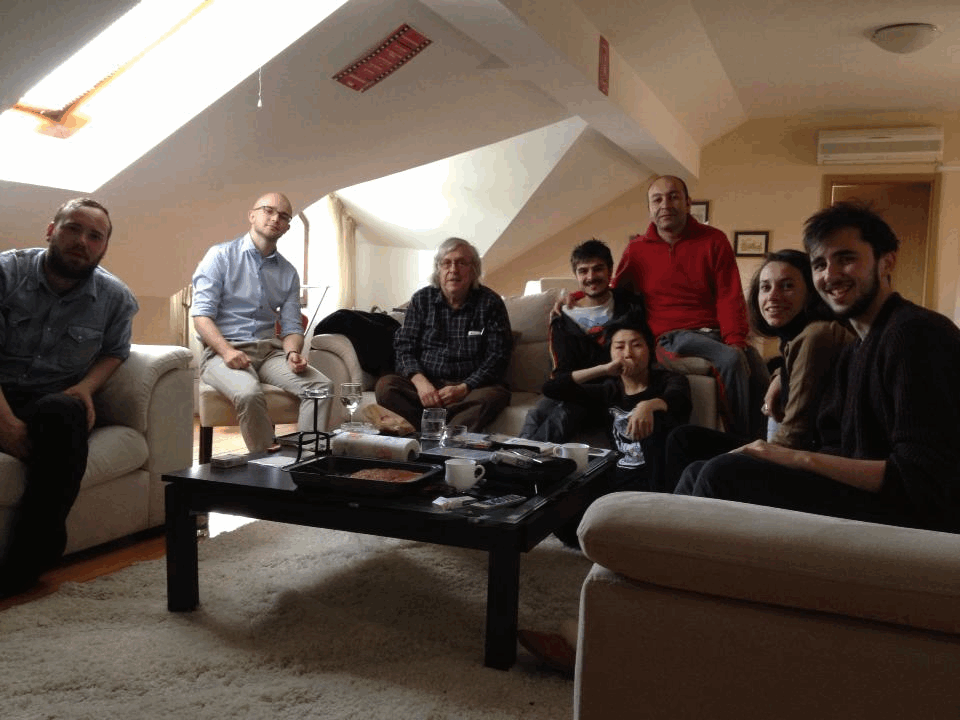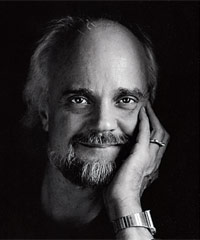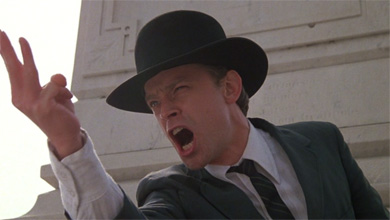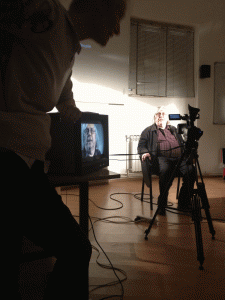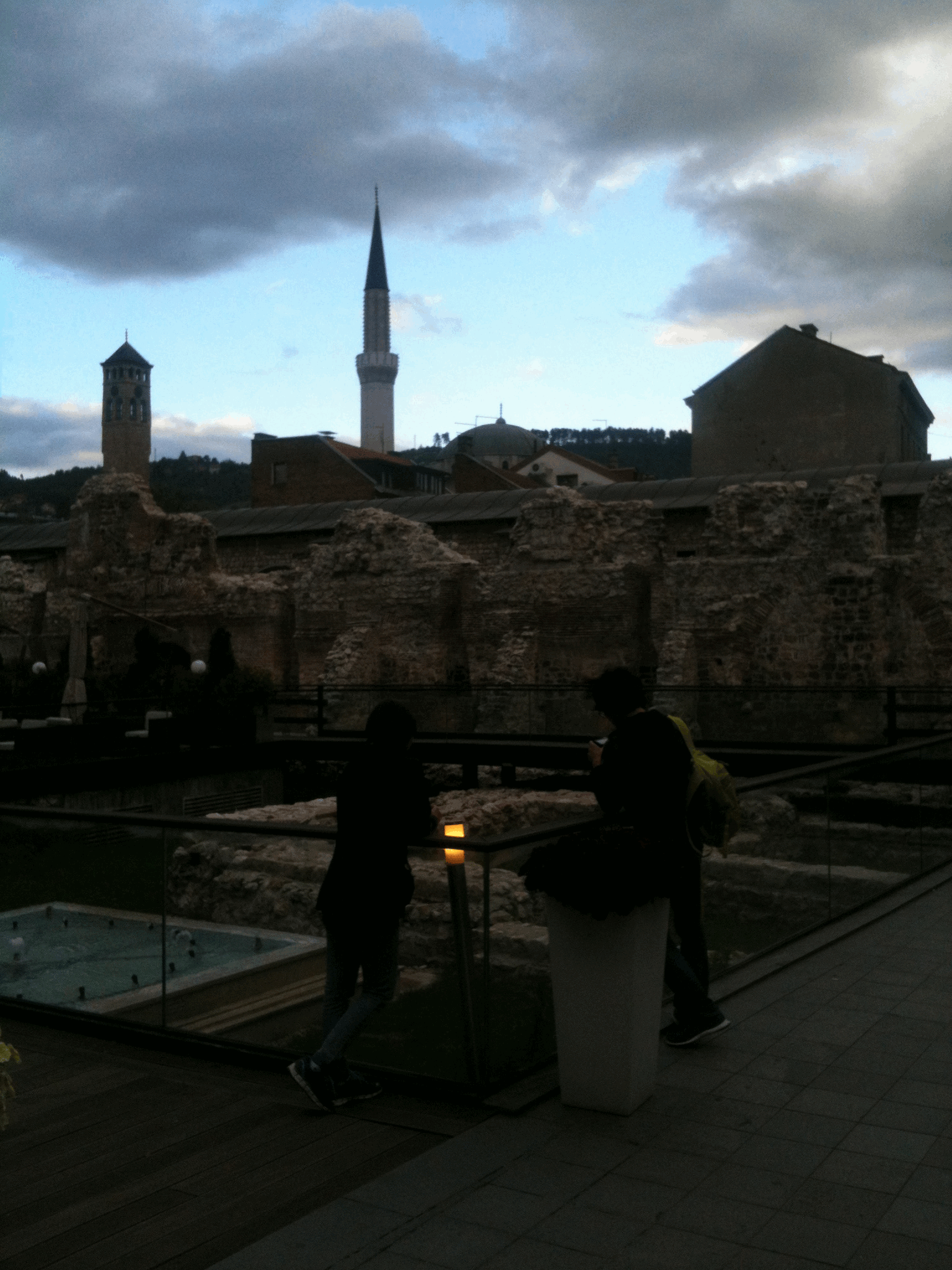Posted on Sight and Sound‘s web site 18 July 2013, and then expanded (by about 50%) at the request of Trafic‘s Raymond Bellour later that month for its French translation in Trafic #88, published in early December. This has also appeared in German translation in the September 2013 issue of Cargo, and a Spanish translation appeared in mid-August 2014 on Roger Koza’s web site. I’ve slightly updated the version here in a few particulars and added some photos.
I returned to Film.Factory for my fourth two-week stint to date on October 24, 2015, this time to teach a history of independent cinema around the world. — J.R.
First of all, what is film.factory?
It’s usually thought of and referred to as a film school that’s been recently set up in Sarajevo, housed at the Sarajevo Film Academy. But Béla Tarr, who created it, isn’t happy with this classification. He’d rather call it a workshop or, as its name suggests, a factory that produces films in which he serves as a producer. And he’d rather speak of the sixteen filmmakers he selected late last year from fourteen countries (Austria, the Czech Republic, France, the Faro Islands, Iceland, Iran, Japan, Mexico, Poland, Portugal, Serbia, Spain, the U.K., and the U.S.) and hundreds of hours of film-viewing for his three year-program — all between the ages of 22 and 38 — as “colleagues” rather than as students. If he’s right, he chose his colleagues well.
But this isn’t to say that his aspirations are entirely free of pedagogical designs. When he first spoke to me of his plans a couple of years ago — at the Era New Horizons Film Festival in Wrocław, Poland, where he was presenting The Turin Horse, already announced as his last film –- he said that part of what he had in mind for what he was then calling his “school project” was to explain how everything his students had already been told about filmmaking was a lie. And he asked me to participate by showing them and speaking about American independent films, leaving it entirely up to me how I would define that category and clarifying that this would be an elective “course” or activity, not a requirement.
Early on, I decided to concentrate on an existential, eclectic, and highly personal definition of “independent” that encompassed Stroheim’s Foolish Wives and Greed (the latter had just become commercially available on a Spanish DVD) and Paul Fejos’ Lonesome as well as Thom Andersen’s Los Angeles Plays Itself, Charles Burnett’s When it Rains, Larry Clark’s Passing Through, Sara Driver’s You Are Not I, James Benning’s 11 X 14, a few short works by Stan Brakhage and Bruce Connor, Albert Brooks’ Real Life, Hollis Frampton’s (nostalgia), Howard Hawks’ Scarface, Todd Haynes’ Safe, John Huston’s Wise Blood, Val Lewton’s The Seventh Victim and I Walked with a Zombie, Richard Linklater’s Bernie, Elaine May’s Mikey and Nicky, Mark Rappaport’s Exterior Night, Nicholas Ray’s Bitter Victory, Mehrnaz Saeed-Vafa’s Jerry and Me, and Leslie Thornton’s Adynata, but only The Struggle when it came to Griffith (although I also included a half-hour radio broadcast by Stroheim speaking about Griffith when he died).
Even though I brought along some features by Chaplin, Welles, and Jarmusch, I ultimately opted in most cases for films they wouldn’t have otherwise seen or even heard about, and for polemical reasons — to argue against the notion that directorial credits necessarily mattered apart from performances — I devoted my first screening session to Chaplin’s One AM and most of Richard Pryor Live in Concert (for me, one of the greatest performance films in the history of cinema — released in the U.S. in 1979, although almost completely unknown in Continental Europe). My desire to show Lonesome, I should add, was spurred not only by the recent release on Criterion of excellent Blu-Ray and DVD editions, but my previous shock at learning that Béla had never seen it. (It was the only screening of mine that he attended, and he was every bit as impressed as I’d hoped he would be; the only previous film by his Hungarian compatriot that he’d previously seen had been Marie, légende hongroise.)
The Pryor film was received quite warmly despite the absence of any subtitles (Pryor’s body language speaks volumes), but after a screening of Josef von Sternberg’s The Saga of Anatahan with French subtitles that was met mainly with incomprehension, I opted whenever possible for films with English subtitles. (Among the sixteen, only the oldest and youngest of the members had grown up with English as a first language –- respectively, Keja Ho Kramer, the daughter of Robert Kramer, who had previously worked in collaboration with both her father and Steve Dwoskin, and Grant Gulczynski, who hailed from London.) One morning, when I was faced with the prospect of showing Ford’s The Long Voyage Home with Spanish subtitles, one of the two Serbs offered and then managed to find and synchronize English subtitles in time for a screening after our lunch break.
Regarding the program as a whole, there are no papers or tests or roll-calling [note: attendance sign-up sheets were introduced in the fall] — just an expectation that two short films be made by each participant the first year, two more the second year, and hopefully a feature the third. As recently as a year ago, Béla still thought it would be in Split, Croatia, but late last July he sent out a letter explaining that getting accreditation there to hand out Ph.Ds was proving impossible, so another location would have to be found; and less than two months later came his email update, with the news that the Sarajevo Film Academy at the local School of Science and Technology would serve as the home base. (Emina Ganić, the Academy’s executive director, became the key administrator.) By the time film.factory started in mid-February, Béla’s break with his past as both a filmmaker and as a Hungarian had become profound, ending many long-term professional as well as personal relationships and effectively sending him into exile. But he was also clearly and, I think, rightly proud of what he had created: a utopian community that manages to remain intense and relaxed at practically every juncture.
It was established that I would be dividing each day during the second half of May with Carlos Reygadas — Carlos doing “practical” sessions in the afternoons, and my lectures and screenings in the mornings, held for whoever wanted to show up (which also included a few M.A. students and other visitors). The original idea was for me to also have public screenings each evening, ideally with some assistance from the U.S. embassy and involving the local community. But shortly before I came, I learned that the embassy hadn’t even answered our letter to them, and the further issue of holding public screenings without the proper rights clearances was proving insuperable. All of which is to say that the potential charge of film.factory being an elitist, club-like affair is one that Béla and others are trying to address, even though a satisfactory long-term solution for accomplishing this has yet to be found.(Theoretically, the Sarajevo Film Festival could offer a path, but the fact that it’s held in the summer when film.factory is no longer in session rules out that possibility.)
However, instead of simply cutting my syllabus in half when I discovered that public screenings weren’t possible, I decided to bring along two or three times as many DVDs as I could possibly show and then thrash out which ones with the students (as I was still calling them at this point), based on their own particular interests and orientations. Before I arrived, I even sent along my preliminary list of possible films to show, along with links to pieces about most of them on my web site and the suggestion that they look at my book Movie Wars to get some sense of my overall approach. During my two weeks of “official” employment, I also managed to lend out a few other DVDs to match certain individual interests (e.g., Martina Kudláček’s documentary on Maya Deren, for a filmmaker who was especially interested in her work, apart from my screenings of Meshes of the Afternoon and At Land, and Jon Jost’s Last Chants for a Slow Dance for someone else). And during the same period, one of the Spanish filmmakers, Pilar Palomero, introduced me to Luis Garcia Berlanga’s corrosive 1963 masterpiece El verdugo by making me a subtitled copy.
But things changed again — or at least my perception of them did. Because the entire operations were being planned exclusively, and on a day-by-day basis, by Béla, working only with his 33-year-old assistant and program coordinator, Sunčica Fradelić (a visual artist from Split who had also become my main email contact), I soon discovered that one of the main reasons why film.factory wasn’t a school was that it was much closer to a film shoot, something Béla knew and understood a lot better. This meant that everything, my screenings and lectures included, was subject to last-minute revisions due to weather, equipment, health, sudden inspirations, and other variables. And bearing in mind Orson Welles’ definition of a film director as someone who presides over accidents — along with the dawning realization that the same vicissitudes might even apply to film historians, and therefore to what we all know as film history — an important part of my own education over my 18 days in Sarajevo was simply learning how to roll with all the punches.
Early on, for instance, I discovered that Carlos had already been teaching for a week before I arrived, and would be leaving after only three more days, leaving the remaining afternoons free. (Before he left, I was able to attend his informative afternoon session devoted to showing and discussing his first feature, Japón — during which he expressed some irritation about the filmmakers not being as punctual or as assertive as he would have liked….Incidentally, the above photo, of the two of us playing chess, was taken by Béla in his flat.) Thus my own screening and lecture time practically doubled again, especially once it became clear that Tilda Swinton, originally slated to replace Carlos, had to delay her own arrival due to her hectic post-Cannes schedule. But fortunately, after my stint was over, I was able to visit the first two of Tilda’s remarkable classes as well as two screening sessions of another lecturer, Manuel Grosso, who hailed from Seville and was focusing on Buñuel. (Among the other visiting lecturers who’d preceded us this year were Jean-Michel Frodon, Thierry Garrel [who returned during the fall], Ulrich Gregor, Fred Kelemen, and Gus van Sant.)
Among the other fruits of last-minute scheduling were a field trip to Bunker Konjic, about an hour’s drive past spectacular mountain scenery from Sarajevo — an underground bomb shelter built by Tito that seemed as large and as crazy as a small country, not to mention a fever dream out of Dr. Strangelove, run today by the Bosnian army and currently housing an international art show; a screening of Béla’s 450-minute Sátántangó one Saturday (the first time Sunčica and nearly all the others saw it), introduced by me and followed the next day by Béla lecturing for four-and-a-half hours about how he filmed it, shot by shot and take by take, using a sort of post-it storyboard as his narrative thread (as with the film itself, there were two intermissions); and an earlier marathon screening arranged by me the previous Saturday, held at an apartment occupied by four of the students, which turned out to be the most memorable session we had. (See below.) Another session of this kind, devoted to the re-edit of Welles’ Touch of Evil that I served as consultant on and, if time and energy permitted, John Gianvito’s The Mad Songs of Fernanda Hussein, was planned at the request of some of my regulars. But then this had to be postponed when the other Serb filmmaker, who had been filming all week, made a call for crew members and extras (including myself in the latter group), for a lengthy, rowdy shoot inside a local bar inside a basement that was reportedly the only such establishment to survive the war — and which quickly became so filled with cigarette smoke that I only remained for a couple of hours. Then eventually our second viewing session was canceled at Béla’s request when he feared that my hefty program of screenings, which eventually totaled 21 features and 17 shorts, might be diverting too much attention and energy away from other parts of the program.
A few words about the Sátántangó screening and its aftermath: Béla asked me to give a short introduction, and approved my suggestion that I start by showing a six-minute video in black and white and long takes that Kevin B. Lee made in late 2013 — a video that followed me walking in my Chicago neighborhood while discussing the film, aping the film’s style in a manner suggested by some of Andre S. Labarthe and Janine Bazin’s TV documentaries. Afterwards, I concluded with an argument that I knew both Béla and his cowriter László Krasznahorkai would refute — that the film had something to say about Communist and Stalinist surveillance and bureaucracy. (Admitting that my entire experience of the Communist world consisted of a single afternoon spent in East Berlin, I avowed that, regardless of his and Krasznahorkai’s intentions, the film none the less reminded me of those few hours, maintaining that sometimes works knew more than their authors did.) The next day, in his lecture and at a meal afterwards, Béla respectfully but firmly disagreed, insisting that the film’s designs were metaphysical and not political — although his partner, Polish film journalist Małgorzata Sadowska, took my side in the debate.
My own screenings generally consisted of brief introductions by me, watching the films straight through, and discussions immediately afterwards. The most popular films were the two Stroheims (especially for the density of the characterizations in Greed and the multiple paradoxes involved in Stroheim, an imposter, playing an imposter in Foolish Wives), the two Lewtons, Bitter Victory, Lonesome, Los Angeles Plays Itself, Mikey and Nicky, (nostalgia), Real Life, Safe, and, most of all, to my delighted surprise, the four films I showed them by Peter Thompson.
This leads me to the one marathon screening we did have. By another accident of chance, I’d received news the night before that Thompson, one of my best friends in Chicago — for me the greatest of all Chicago filmmakers, past or present, even though he continues to be among the least well known, and someone whom I’d befriended in the late 80s because of how I felt about his work — had died, at age 69, after 18 months of terminal illness. (I’m happy to report that a box set including all six of his films and a lengthy interview, meticulously prepared by Peter himself, is now available on Amazon: Peter Thompson: 6 Cinematic Essays + 2 Interviews + …) I intended to show only his half-hour Universal Hotel (1986) on Saturday, but it had such an impact on those present that I wound up screening all three of Thompson’s other highly personal films of his that I’d brought to Sarajevo: Universal Citizen (1986) and his Two Portraits (1982), the latter about each of his parents. The film about his father, Anything Else, stretches out a few seconds of home-movie footage of his father in an airport to almost fifteen minutes of successive stills, accompanied by Peter’s own narration.
During his late teens and early 20s, Peter had studied classical guitar with Andrès Segovia and performed at concerts in Europe, and combined with his subsequent academic work in comparative literature, this gives his distinctive voiceovers a literary as well as musical address — “the capacity to suggest infinite reaches with a minimum of photographic ‘evidence’, carefully chosen words, and the articulation of his own voice,” as I later put it on my own web site. And I think what impressed my Filmfactory colleagues above all in the four films they saw was Peter’s narration, which figures in all of them except for the film about his mother, Shooting Scripts, despite the absence of any subtitles — both as beautiful, sculpted writing (singled out by Mohammadreza Farzad, who translates contemporary American poetry and fiction into Farsi), and for its inherent musical form of delivery. Also for its feeling, and for what Kaori Oda described to me in a subsequent email as the “strong form” of the rhythm of his images, which made her miss Osaka and “my dear people” there and gave her “a vast space to reflect myself”, while responses from several others at the screening, all of which I was able to convey to Peter’s widow, were equally strong and personal.
A few years ago, I collaborated with Peter on an article and interview about his work (1), and here is an “outtake” from our email exchanges that seems especially relevant to what moved my colleagues the most:
“Earlier, Jonathan, you mentioned the films’ voice-overs — that they seem to suppress overt emotional expressiveness in order to allow other qualities to surface. You mention ‘Bresson’ in relation to those other qualities. Let me try to amplify what you are pointing to. This style evolved during the voice-over recordings for Two Portraits. I was mortified by the first voice-over: it was so over the top, emotionally — an audience would have recoiled. I re-recorded. Again, bad — this time it flew below the emotional radar. I realized that I should try to hold the tension between those two emotional states. Five weeks and five recordings later…I had a voice-over that seemed to hold that tension. Finally! The difference — besides the positive lessons reaped from the failures — was the memory of a stunningly wonderful concert in 1966: the first visit to France by the Berlin Philharmonic since the outbreak of WWII. Herbert von Karajan conducted Mozart’s ‘Haffner’ symphony. Von Karajan stood on the podium, almost immobile, as if anxious not to deflect attention from the music’s agonizingly complicated simplicity. He hid his arms and his hands. What were visible were his back muscles. They testified to a man on the verge of exploding. The artistic and emotional power generated from his almost successfully suppressed emotion seemed to fill Chartres Cathedral. What a balancing act! The tension of that remembered experience became the goal of my subsequent voice-overs.
“This goal depends upon honed down scripts and simple writing.…I’m an admirer of the style blanc practiced by the Polish post-war poets Czeslaw Milosz, Zbigniew Herbert and Wislawa Szymborska. They write ‘transparently’ with zero extra words and very few adjectives. To shrink downward to that blessed state, I write an embarrassingly large number of drafts because it takes me a while to recognize one word too many….As you join these three elements together — perceivable rhythm […], the ‘von Karajan paradox’, and the ‘white style’ — a miraculous effect can sometimes occur. I can’t judge in advance when, or if, it might happen, but can only recognize with gratitude when it does — suddenly, without warning, everything in the voice-over accrues into a quietly overwhelming affect. It’s not possible to point to a single word or single utterance that’s caused it. Accrual. Segovia used to say, ‘Better to move than to amaze.’ He moved with small means.”
For me, showing Peter’s work was the high point of all the sessions I’d initiated, but the comments offered at many of the screenings were often acute; I was particularly struck by Stefan Malesevic’s observation about how warmly the characters in Wise Blood were portrayed, in spite of all the caustic black humor, which made me realize for the first time how decisively the film differed from Flannery O’Connor’s novel, despite the close fidelity to the text. But the two extended lectures of Tilda Swinton I attended over a week later, about the ethics and practice of dealing with performers, were no less exciting, and interestingly enough, they were no less related to Bresson. Both of her lectures used Notes on Cinematography as a major reference point, and even though this might seem eccentric, it turned out to be concrete and practical, especially once Tilda started filming close-ups of everyone in turn, visible on a monitor, while conversing with each of us on the second day. (I was the first guinea pig in this process.)
The focus was mostly on how actors/performers, rather than seek to “express themselves,” should minimize their expressions to what’s needed in a particular shot in order to advance a story, and the public dialogues she had with each of us were demonstrations and elucidations of this process, highlighting the degree to which less — by virtue of being isolated and magnified by the camera — invariably registered as more. Asking each of us to think about something private without verbalizing it was a way of getting us to concentrate and thus empty our faces so that small details started to register. When she asked Pilar — who had previously snapped the above photo of Tilda filming me — to pretend she was riding home on a bus, totally exhausted, and so tired that she didn’t even have enough energy to close her mouth, the way her open mouth transformed her close-up on the monitor so that it immediately signified “exhaustion” was immediately apparent.
As I said to Tilda afterwards, I felt like I had just been through a session with Socrates. This wasn’t only because of the interactive nature of her workshop and how responsive she was to what others were saying (at one point during the second half of her lecture, she briefly and pointedly replied to a casual remark I’d made to someone else during a break, which I hadn’t even realized she’d overheard), but also because of her solid grounding in so many different kinds of cinema -– having begun her career working in the experimental films of Derek Jarman and subsequently traversed everything from the commercial mainstream (Wes Anderson, Michael Apted, the Coen brothers, Cameron Crowe, David Fincher, Spike Jonze) to many kinds of art cinema (Joon-ho Bong, Jim Jarmusch, David Mackenzie, Sally Potter, Lynne Ramsey, Béla Tarr). Such versatility is relatively common in French cinema but virtually nonexistent in the Anglo-American world, and her sense of her own identity within that world seems no less acute. (At one point she remarked in passing that she doesn’t look like anyone else in films but looks like a lot of other people in paintings.)
In closing, I should note that I didn’t start looking at films already made by the “factory workers” until after I returned home, so my experience of film.factory was appreciably different from those of Béla, Carlos, and others more engaged with their actual practice. (The only quality approaching a common trait would be that they mainly have some relation to “art cinema,” even though, apart from a preference for black and white among many of them, there are significantly no obvious imitations of Béla Tarr’s filmmaking.) For me, it was an adventure having a lot to do with joining and then engaging with a particular community — something I do more often nowadays via the Internet, but one in this case that extended my online activity as a writer rather than forge some alternative to it.
Maybe it’s some form of teaching after all, despite what Béla says. But as Tilda and her hyper-alertness clarified, it’s reciprocal education founded on a Socratic model — conversations and dialogue, not preaching and pronouncements. In the past, I’ve often felt hamstrung by students firmly convinced that they can learn anything they need to know without reading. So it was no small pleasure to discover back in Chicago that over 200 visits from Sarajevo had been paid to my web site over the previous month.
Postscript (2021)
FilmFactory reluctantly had to close due to financial difficulties in December 2016.
Footnote
1. “A Handful of World: The Films of Peter Thompson, An Introduction and Interview,” Film Quarterly, Fall 2009.

